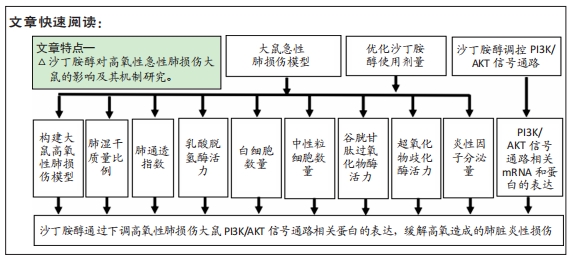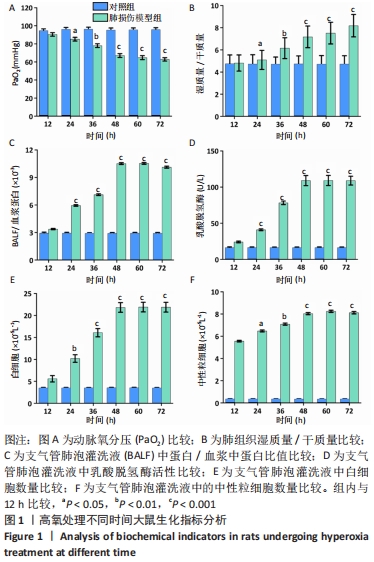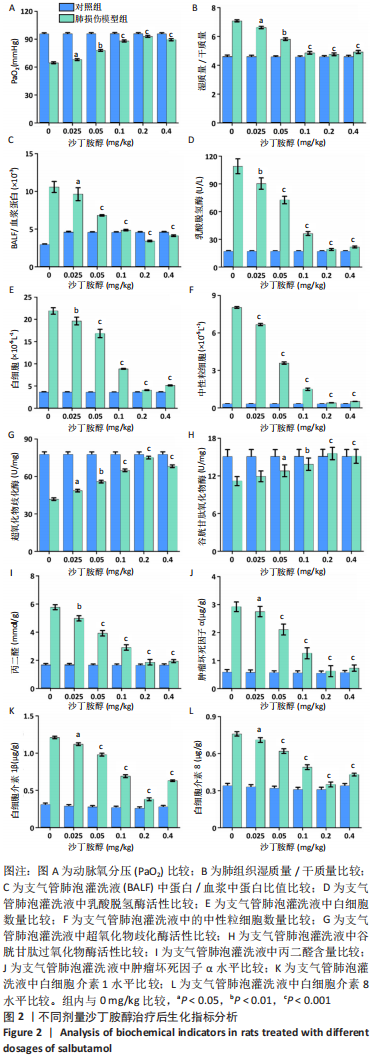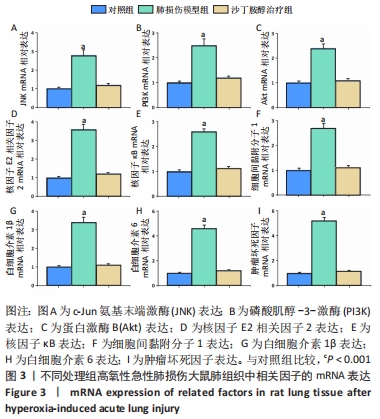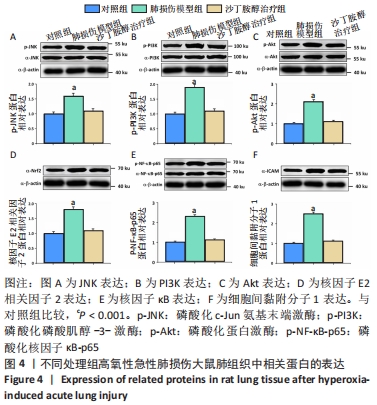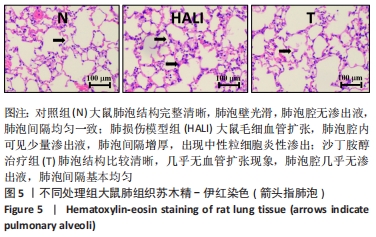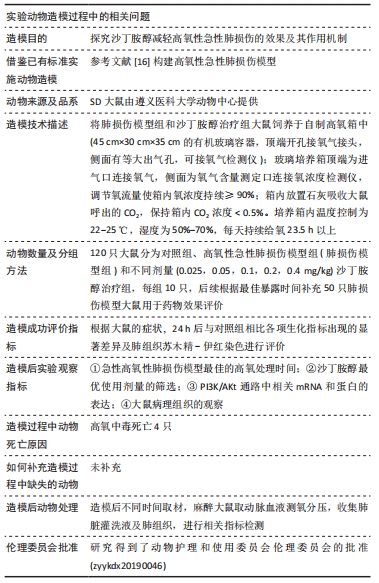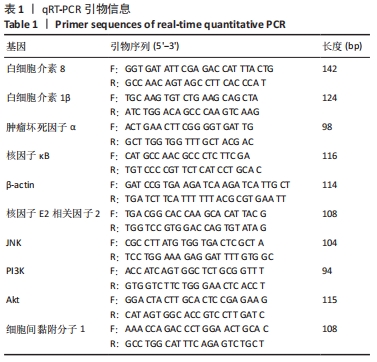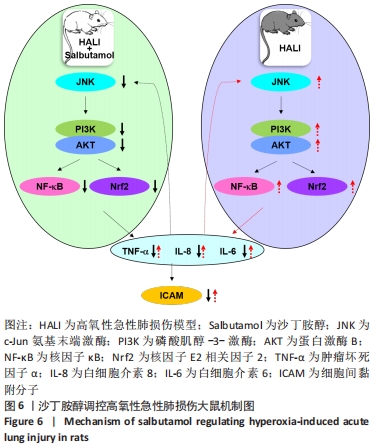[1] PAN YQ, HOU A. Hyperoxia-induced lung injury increases CDKN1A levels in a newborn rat model of bronchopulmonary dysplasia. Exp Lung Res. 2018;44(8-9):424-432.
[2] CHEN CM, HWANG J, CHOU HC, et al. Tn (N-acetyl-d-galactosamine-O-serine/threonine) immunization protects against hyperoxia-induced lung injury in adult mice through inhibition of the nuclear factor kappa B activity. Int Immunopharmacol. 2018;59:261-268.
[3] HONG CY, ZHANG HD, LIU XY, et al. Attenuation of hyperoxic acute lung injury by Lycium barbarum polysaccharide via inhibiting NLRP3 inflammasome. Arch Pharm Res. 2019;42(10):902-908.
[4] RATHINASABAPATHY A, HOROWITZ A, HORTON K, et al. The Selective Angiotensin II Type 2 receptor agonist, compound 21, attenuates the progression of lung fibrosis and pulmonary hypertension in an experimental model of bleomycin-induced lung injury. Front Physiol. 2018;9:180.
[5] JABBAL S, LIPWORTH BJ. Sensitivity of lung resistance and compliance to beta-blocker induced bronchoconstriction and long acting beta-agonist withdrawal in COPD. Lung. 2018;196(1):15-18.
[6] LEWIS SR, PRITCHARD MW, THOMAS CM, et al. Pharmacological agents for adults with acute respiratory distress syndrome. Cochrane Database Syst Rev. 2019;7(7):CD004477.
[7] WU X, LI S, WANG X, et al. Therapeutic role of terbutaline in a rat whole-lung lavage model.Exp Lung Res. 2011;37(9):542-548.
[8] SALDIAS FJ, LECUONA E, COMELLAS AP, et al. beta-adrenergic stimulation restores rat lung ability to clear edema in ventilator-associated lung injury. Am J Respir Crit Care Med. 2000;162(1):282-287.
[9] BOSMANN M, GRAILER JJ, ZHU K, et al. Antiinflammatory effects of beta2 adrenergic receptor agonists in experimental acute lung injury. FASEB J. 2012;26(5):2137-2144.
[10] WANG Z, LV Y, ZHANG D, et al. In Vivo Effects of Salbutamol Residues on Blood Lipid, Lung Structure, Gene Expression, and Gut Microorganism Composition. ACS Omega. 2019;4(24):20644-20653.
[11] POZZOLI C, BERTINI S, POLI E, et al. Relaxing effects of clenbuterol, ritodrine, salbutamol and fenoterol on the contractions of horse isolated bronchi induced by different stimuli. Res Vet Sci. 2020;128:43-48.
[12] SUN Y, QIN L, LIU C, et al. Exploring the influence of drug content on DPI powder properties and potential prediction of pulmonary drug deposition. Int J Pharm. 2020;575:119000.
[13] ZHANG R, WU J, LIU S, et al. Spatial Distribution of (R)-salbutamol in Rat Brain Following Nasal and Intravenous Administration Using DESI-MS. Pharmaceutics. 2020;12(1):35.
[14] LOURENÇO LO, LOPES ACR, ZAVAN B, et al. Vagotomy influences the lung response to adrenergic agonists and muscarinic antagonists. Respir Physiol Neurobiol. 2020;274:103358.
[15] MORI A, HIGASHI K, WAKAO S, et al. Probucol prevents the attenuation of β 2-adrenoceptor-mediated vasodilation of retinal arterioles in diabetic rats. 2017;390(12):1247-1253.
[16] 石敏. 高氧性急性肺损伤(HALI)的炎症发生机制及内毒素血症对HALI的影响[D]. 北京:中国人民解放军军医进修学院,2007.
[17] PATIL SS, HERNÁNDEZ-CUERVO H, FUKUMOTO J, et al. Alda-1 attenuates hyperoxia-induced mitochondrial dysfunction in lung vascular endothelial cells. Aging (Albany NY). 2019;11(12):3909.
[18] WU Q, CHONG L, SHAO Y, et al. Lipoxin A4 reduces hyperoxia-induced lung injury in neonatal rats through PINK1 signaling pathway. Int Immunopharmacol. 2019;73:414-423.
[19] ZHENG G, REN H, LI H, et al. Lycium barbarum polysaccharide reduces hyperoxic acute lung injury in mice through Nrf2 pathway. Biomed Pharmacother. 2019;111:733-739.
[20] 周学军. 大剂量多种药物中毒致呼吸心跳骤停1例抢救成功体会[J]. 中国中医急症,2010,19(2):335-335.
[21] 陈一农, 张吟, 郑兴中, 等. 中毒剂量与治疗剂量克仑特罗在兔体内的药动学研究[J]. 中国现代应用药学,2005,22(4):272-275.
[22] CHOI S, JEON S, YIM DS, et al. Contribution of Trough Concentration Data in the Evaluation of Multiple-Dose Pharmacokinetics for Drugs with Delayed Distributional Equilibrium and Long Half-Life. Drug Des Devel Ther. 2020;14:811-821.
[23] WANG X, WANG J. Analysis of the advantages and disadvantages in application of oxygen-driven aerosol and aerosol inhalation by air compressor for the pediatric asthma.Pak J Pharm Sci. 2018;31 (6(Special)):2847-2850.
[24] TIZIANO FD, LOMASTRO R, ABIUSI E, et al. Longitudinal evaluation of SMN levels as biomarker for spinal muscular atrophy: results of a phase IIb double-blind study of salbutamol. J Med Genet. 2019;56(5):293-300.
[25] DEMIREL BD, AYÇIÇEK T, GÜN S, et al. Evaluation of the histopathological effects of salbutamol inhaler treatment in an experimentally induced rat model of pulmonary contusion.Turk J Med Sci. 2018;48(6): 1285-1292.
[26] GRAILER JJ, HAGGADONE MD, SARMA JV, et al. Induction of M2 regulatory macrophages through the β2-adrenergic receptor with protection during endotoxemia and acute lung injury. J Innate Immun. 2014;6(5):607-618.
[27] WU X, WANG Z, QIAN M, et al. Adrenaline stimulates the proliferation and migration of mesenchymal stem cells towards the LPS-induced lung injury. J Cell Mol Med. 2014;18(8):1612-1622.
[28] BLENK N, KUNKEL SL. Endogenous norepinephrine regulates tumor necrosis factor-α production from macrophages in vitro. J Immunol. 1994;152(6):3024-3031.
[29] HUANG JL, ZHANG YL, WANG CC, et al. Enhanced phosphorylation of MAPKs by NE promotes TNF-α production by macrophage through α adrenergic receptor.Inflammation. 2012;35(2):527-534.
[30] DONNELLY LE, TUDHOPE SJ, FENWICK PS, et al. Effects of formoterol and salmeterol on cytokine release from monocyte-derived macrophages. Eur Respir J. 2010;36(1):178-186.
[31] SAMANTA J, SINGH S, ARORA S, et al. Cytokine profile in prediction of acute lung injury in patients with acute pancreatitis. Pancreatology. 2018;18(8):878-884.
[32] XU F, LUO M, HE L, et al. Necroptosis contributes to urban particulate matter-induced airway epithelial injury. Cell Physiol Biochem. 2018; 46(2):699-712.
[33] DING Q, LIU G, ZENG Y, et al. Glycogen synthase kinase‑3β inhibitor reduces LPS‑induced acute lung injury in mice. Mol Med Rep. 2017; 16(5):6715-6721.
[34] QIU Y, XIAO Z, WANG Y, et al. Optimization and anti-inflammatory evaluation of methyl gallate derivatives as a myeloid differentiation protein 2 inhibitor. Bioorg Med Chem. 2019;27(20):115049.
[35] IBRAHIM YF, MOUSSA RA, BAYOUMI AMA, et al. Tocilizumab attenuates acute lung and kidney injuries and improves survival in a rat model of sepsis via down-regulation of NF-κB/JNK: a possible role of P-glycoprotein. Inflammopharmacology. 2020;28(1):215-230.
[36] ZHANG Y, HUANG T, JIANG L, et al. MCP-induced protein 1 attenuates sepsis-induced acute lung injury by modulating macrophage polarization via the JNK/c-Myc pathway. Int Immunopharmacol. 2019; 75:105741.
[37] JIN H, YANG X, ZHAO K, et al. Glycogen synthase kinase-3 beta inhibitors protectagainst the acute lung injuries resulting from acute necrotizing pancreatitis.Acta Cir Bras. 2019;34(6):e201900609.
[38] GAUDET A, PORTIER L, PRIN M, et al. Endocan regulates acute lung inflammation through control of leukocyte diapedesis. J Appl Physiol (1985). 2019;127(3):668-678.
[39] ZHANG C Y, LIN W, GAO J, et al. pH-Responsive Nanoparticles Targeted to Lungs for Improved Therapy of Acute Lung Inflammation/Injury. ACS Appl Mater Interfaces. 2019;11(18):16380-16390.
[40] LI G, ZHOU L, ZHANG C, et al. Insulin-like growth factor 1 regulates acute inflammatory lung injury mediated by influenza virus infection. Front Microbiol. 2019;10:2541.
[41] SUI H, LUO M, MIAO Y, et al. Cystic fibrosis transmembrane conductance regulator ameliorates lipopolysaccharide-induced acute lung injury by inhibiting autophagy through PI3K/AKT/mTOR pathway in mice. Respir Physiol Neurobiol. 2020;273:103338.
[42] SHI J, YU J, ZHANG Y, et al. PI3K/Akt pathway-mediated HO-1 induction regulates mitochondrial quality control and attenuates endotoxin-induced acute lung injury. Lab Invest. 2019;99(12):1795-1809.
|
